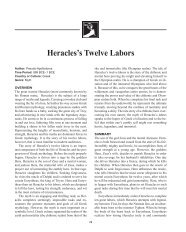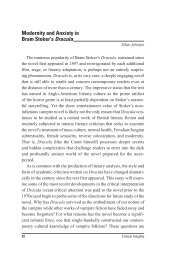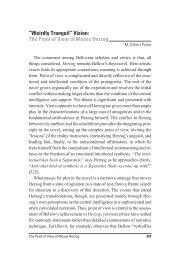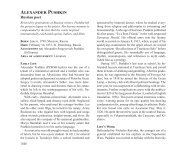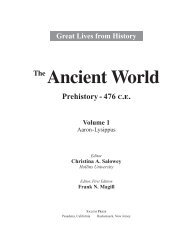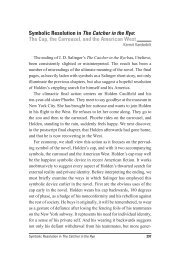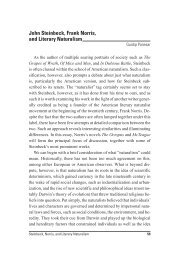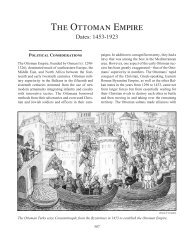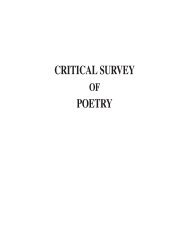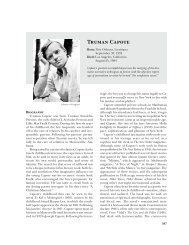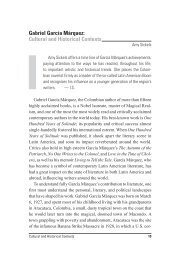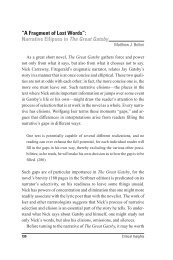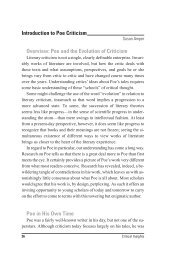The Historical and Social Context of Gwendolyn ... - Salem Press
The Historical and Social Context of Gwendolyn ... - Salem Press
The Historical and Social Context of Gwendolyn ... - Salem Press
Create successful ePaper yourself
Turn your PDF publications into a flip-book with our unique Google optimized e-Paper software.
“<strong>The</strong> Anniad” is in seven-line stanzas recalling octava rima <strong>and</strong> rhyme<br />
royal. It echoes the mock-heroic style <strong>of</strong> eighteenth-century poets, but<br />
the tale is realistic <strong>and</strong> tragic. By ironically using European poetic convention<br />
to convey Annie’s sad fate, in which the realization <strong>of</strong> her<br />
dream is inverted, Brooks suggests the culpability <strong>of</strong> white male narratives.<br />
In the sonnet sequence in “<strong>The</strong> Womanhood,” Brooks’s speaker’s<br />
words are cast in sonnets to present arguments against the institution <strong>of</strong><br />
poverty <strong>and</strong> to highlight the limitations it imposes on African American<br />
women <strong>and</strong> their children.<br />
Several poems in <strong>The</strong> Bean Eaters (1960), Brooks’s third collection,<br />
deal with the murders <strong>of</strong> blacks by racist whites, with a focus on<br />
women’s perspectives. “A Bronzeville Mother Loiters in Mississippi.<br />
Meanwhile, a Mississippi Mother Burns Bacon,” <strong>and</strong> “<strong>The</strong> Last Quatrain<br />
<strong>of</strong> the Ballad <strong>of</strong> Emmett Till” mourn the death <strong>of</strong> Emmett Till,<br />
who was brutally tortured <strong>and</strong> murdered <strong>and</strong> whose body was mutilated<br />
beyond recognition in 1955 in Money, Mississippi. <strong>The</strong> fourteenyear-old<br />
boy from the South Side <strong>of</strong> Chicago was accused <strong>of</strong> whistling<br />
at a white woman. An all-white jury acquitted the men who were<br />
charged with his death. Photographs <strong>of</strong> Till’s body appeared in the Chicago<br />
Defender, as his mother had an open-casket viewing for thous<strong>and</strong>s<br />
to witness. This horrific sight helped press forward the urgency<br />
<strong>of</strong> the Civil Rights movement <strong>and</strong> had no small impact on Brooks. <strong>The</strong><br />
companion poems diacritically present the problem <strong>of</strong> treating atrocity<br />
within the confines <strong>of</strong> a literary form.<br />
In a highly symbolic short narrative, the first poem portrays the<br />
woman who made the accusations against Till <strong>and</strong> hints at her second<br />
thoughts as she watches her children <strong>and</strong> her husb<strong>and</strong>, one <strong>of</strong> the murderers.<br />
<strong>The</strong> glimmerings <strong>of</strong> the woman’s sense <strong>of</strong> guilt come to light as<br />
a bloody redness infuses everything she sees. She also perceives a troubling<br />
violence in her husb<strong>and</strong> as he slaps one <strong>of</strong> his sons after the child<br />
threw a jar at his brother. This pairing <strong>of</strong> brothers symbolically plays<br />
out the violence visited upon blacks by their white brothers. In addition,<br />
through the pairing <strong>of</strong> mothers in the title, Brooks points to the in-<br />
30 Critical Insights



